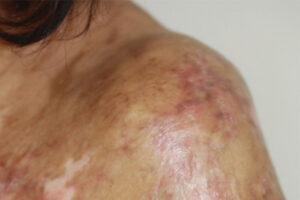Oncology
Chronic Graft-versus-Host Disease
Incidence of and Risk Factors for Chronic Graft-versus-Host Disease
Several important risk factors for the development and severity of chronic graft-versus-host disease (cGVHD) have been identified. Research into the immunologic drivers of cGVHD is burgeoning, and the evolving science could enhance cGVHD risk prediction, identification, and prevention.
Yes, cGVHD is a multiorgan disease, and it takes many different disciplines working together to provide optimal care. We are hematologists, or transplant professionals, by training, so we rely on individuals in other disciplines (eg, dentistry, ophthalmology, and rheumatology) in many important ways. This need has been increasingly appreciated, and now there are clinicians who are interested in ocular and oral GVHD, for example. When patients can be seen by a specialist who is familiar with cGVHD of the eye or the mouth, not only can the specialist identify a potential issue earlier but they can also utilize interventions that are specific to the patients’ needs.
One of the manifestations of cGVHD that has, unfortunately, been underrecognized is gynecologic GVHD. There is an unmet need for our female patients who may have significant sexual dysfunction and vulvar sclerosis because they have cGVHD of the genital area—and no one has actually screened for this or has asked them about it.
We need to educate our referring physicians and primary care doctors to be vigilant for any suspicious symptoms of cGVHD on any part of the body and to be ready to send the patient for follow-up with the transplant center when concerning symptoms are identified.
One could say that virtually every patient undergoing allogenic transplant has some form of cGVHD, and, if you look hard enough, you will find it. One thing that really challenges us is the lack of objectivity in how we assess cGVHD. We rely on very subjective end points that often relate to patient experiences, which are obviously very important, but they are also very difficult to quantify in any consistent way.
A number of research groups are trying to develop more objective biomarkers; however, this is difficult because cGVHD is a highly variable disorder, and it impacts people in very different ways. For example, some patients have milder symptoms such as dry, scratchy eyes while others develop life-threatening lung disorders. Symptoms are so variable that it is very difficult to accurately determine the incidence of cGVHD. Nonetheless, consensus groups are leading important efforts to standardize the assessment of patients for cGVHD using tools that quantify the impact on all organ systems.
To me, one of the most important risk factors for cGVHD is the graft. For instance, using mobilized peripheral blood comes with a higher risk of developing cGVHD than using bone marrow, but it also has a lower risk of relapse. We are always trying to balance the risk of developing cGVHD with the risk of relapse. Ultimately, I think that our field needs more objective criteria that are not quite as subjective as the current systems that we use.
The so-called classic risk factors for the development of cGVHD include older donors, older recipients, and more active disease that may relate to the amount of inflammation at the time of transplant. Even though the crude measures of risk are useful in predicting cGVHD, it would be wonderful to get beyond them and have dynamic prognostication.
In the future, we hope to utilize algorithms and computing technology to calculate individualized cGVHD risk scores that are clinically relevant. Unrelated donors also have greater differences in minor histocompatibility antigens that can explain cGVHD. In the modern era, laboratories are starting to compare genetic polymorphisms in the donor with those in the recipient to determine mismatches. You can go further and try to predict which ones are likely immunogenic.
There are also efforts to look at biomarkers in recipients post transplant, including patterns of immune reconstitution and recovery. Some research suggests that the failure of the thymus to adequately reconstitute regulatory T cells may be linked to the subsequent development of cGVHD, and that biologically makes sense. Other research has highlighted abnormal B cells that are auto- and alloreactive and may predict the development of cGVHD. This is certainly supported by work that has found that autoreactive antibodies can precede the development of clinically apparent GVHD. I feel that we are on the cusp of a big data revolution in cGVHD, where all of the data in well-annotated clinical datasets could transform our prognostic view into something more holistic.
Csanadi M, Agh T, Tordai A, et al. A systematic literature review of incidence, mortality, and relapse of patients diagnosed with chronic graft versus host disease. Expert Rev Hematol. 2019;12(5):311-323. doi:10.1080/17474086.2019.1605288
El-Jawahri A. What else do I need to worry about when treating graft-versus-host disease? Hematology Am Soc Hematol Educ Program. 2021;2021(1):655-661. doi:10.1182/hematology.2021000302
Flinn AM, Gennery AR. Recent advances in graft-versus-host disease. Fac Rev. 2023;12:4. doi:10.12703/r/12-4
Gail LM, Schell KJ, Łacina P, et al. Complex interactions of cellular players in chronic graft-versus-host disease. Front Immunol. 2023;14:1199422. doi:10.3389/fimmu.2023.1199422
Hamilton BK. Updates in chronic graft-versus-host disease. Hematology Am Soc Hematol Educ Program. 2021;2021(1):648-654. doi:10.1182/hematology.2021000301
Jagasia MH, Greinix HT, Arora M, et al. National Institutes of Health consensus development project on criteria for clinical trials in chronic graft-versus-host disease: I. The 2014 diagnosis and staging working group report. Biol Blood Marrow Transplant. 2015;21(3):389-401.e1. doi:10.1016/j.bbmt.2014.12.001
Kok LMC, Bungener L, de Bock GH, et al. Risk factors associated with the development of moderate to severe chronic graft-versus-host disease after non-myeloablative conditioning allogeneic stem cell transplantation in patients with AML or MDS. Hum Cell. 2020;33(1):243-251. doi:10.1007/s13577-019-00297-7
Logan BR, Fu D, Howard A, et al. Validated graft-specific biomarkers identify patients at risk for chronic graft-versus-host disease and death. J Clin Invest. 2023;133(15):e168575. doi:10.1172/JCI168575
Machado AMN, Rodrigues M, Malvezzi H, de Azevedo Piccinato C, Hamerschlak N, Podgaec S. Graft-versus-host disease in the female genital tract: a prospective cohort study. Arch Gynecol Obstet. 2022;305(6):1551-1558. doi:10.1007/s00404-021-06330-1
Mehta RS, Saliba RM, Alsfeld LC, et al. Bone marrow versus peripheral blood grafts for haploidentical hematopoietic cell transplantation with post-transplantation cyclophosphamide. Transplant Cell Ther. 2021;27(12):1003.e1-1003.e13. doi:10.1016/j.jtct.2021.09.003
Pellegrini M, Bernabei F, Barbato F, et al. Incidence, risk factors and complications of ocular graft-versus-host disease following hematopoietic stem cell transplantation. Am J Ophthalmol. 2021;227:25-34. doi:10.1016/j.ajo.2021.02.022
Preston M, Richards A. Vulvar and vaginal graft versus host disease after allogeneic stem cell transplant—a systematic review. J Low Genit Tract Dis. 2023;27(3):266-274. doi:10.1097/LGT.0000000000000738













